Strategic Management Report: H&M in the Fast Fashion Industry Analysis
VerifiedAdded on 2023/01/04
|13
|3180
|93
Report
AI Summary
This report provides a comprehensive strategic analysis of H&M, a prominent player in the fast fashion industry. It begins with an introduction to strategic management and a brief overview of H&M's operations. The report then delves into the external environment using PESTLE analysis to assess political, economic, social, technological, legal, and environmental factors affecting H&M. A competitive analysis using Porter's Five Forces is also conducted to evaluate the industry's dynamics. The internal environment is examined through SWOT and VRIO analyses, identifying H&M's strengths, weaknesses, opportunities, and threats, as well as its valuable, rare, inimitable, and organizationally supported resources. The report explores various strategic options available to H&M, including Porter's Generic Strategies (Cost Leadership, Differentiation, Cost Focus, Differentiation Focus) and the Ansoff Matrix (Market Penetration, Market Development, Product Development, Diversification). Additionally, Bowman's Strategic Clock is used to evaluate strategic directions based on price and perceived value. The report concludes with a strategy selection and justification, providing recommendations for H&M's future strategic direction.
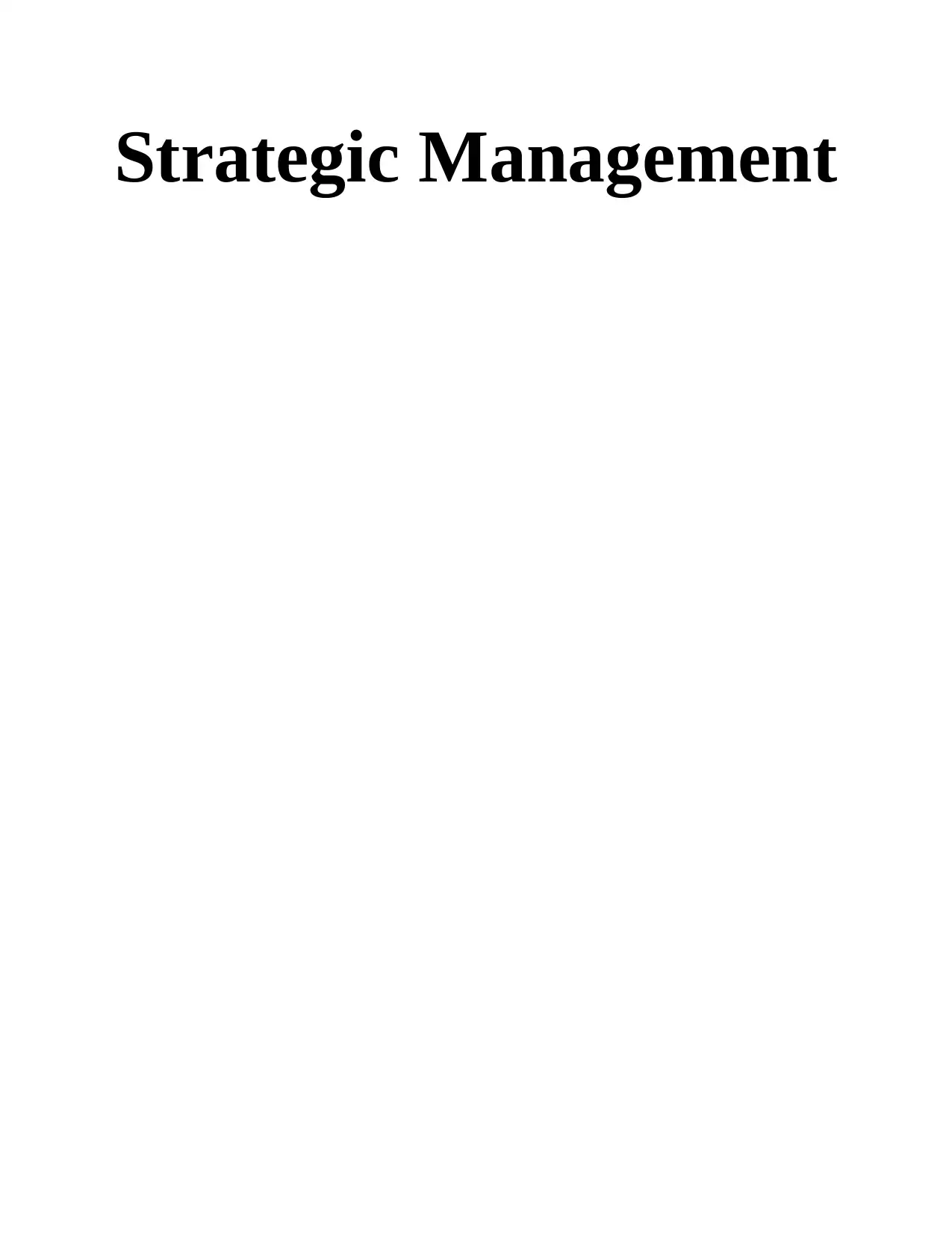
Strategic Management
Paraphrase This Document
Need a fresh take? Get an instant paraphrase of this document with our AI Paraphraser
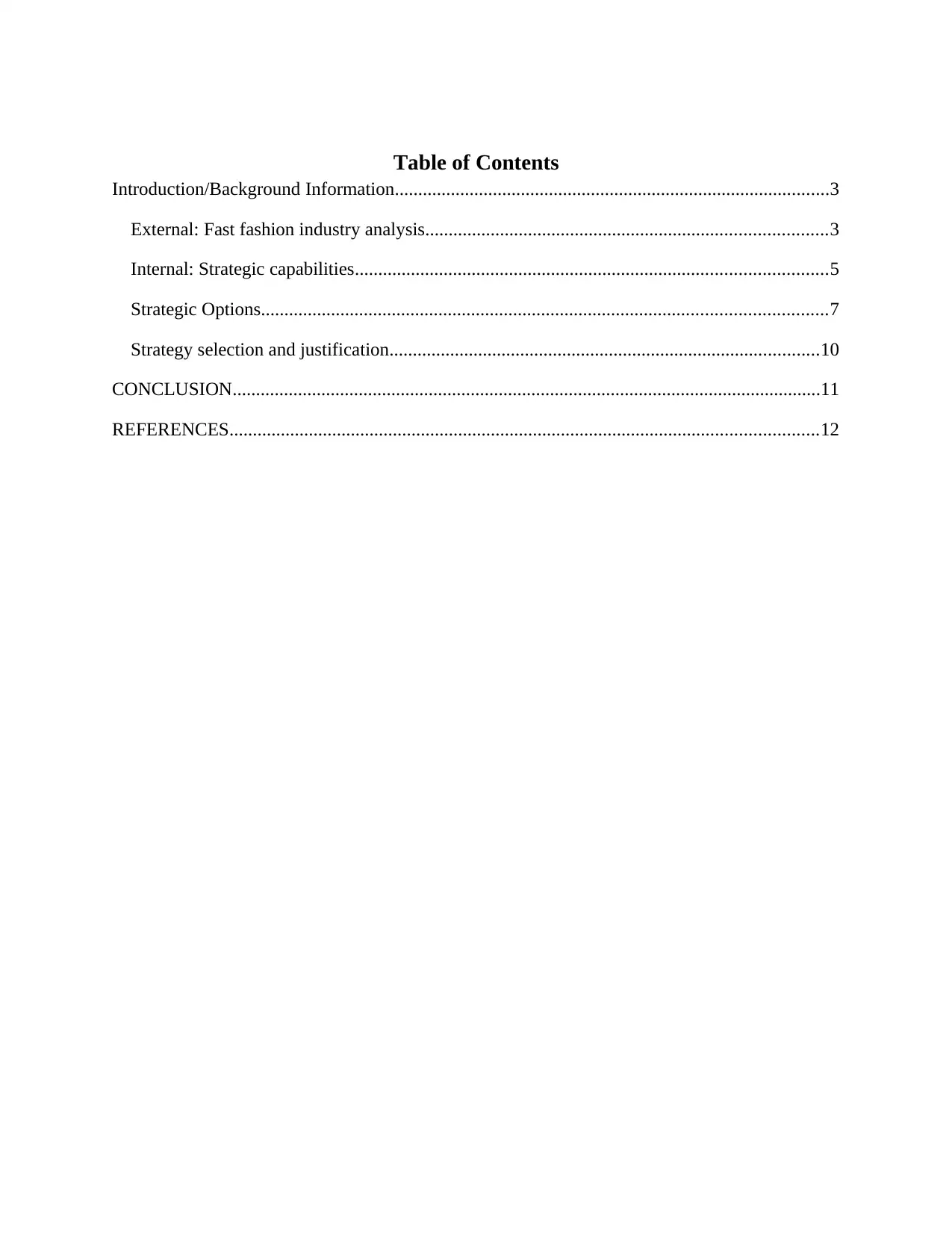
Table of Contents
Introduction/Background Information.............................................................................................3
External: Fast fashion industry analysis......................................................................................3
Internal: Strategic capabilities.....................................................................................................5
Strategic Options.........................................................................................................................7
Strategy selection and justification............................................................................................10
CONCLUSION..............................................................................................................................11
REFERENCES..............................................................................................................................12
Introduction/Background Information.............................................................................................3
External: Fast fashion industry analysis......................................................................................3
Internal: Strategic capabilities.....................................................................................................5
Strategic Options.........................................................................................................................7
Strategy selection and justification............................................................................................10
CONCLUSION..............................................................................................................................11
REFERENCES..............................................................................................................................12
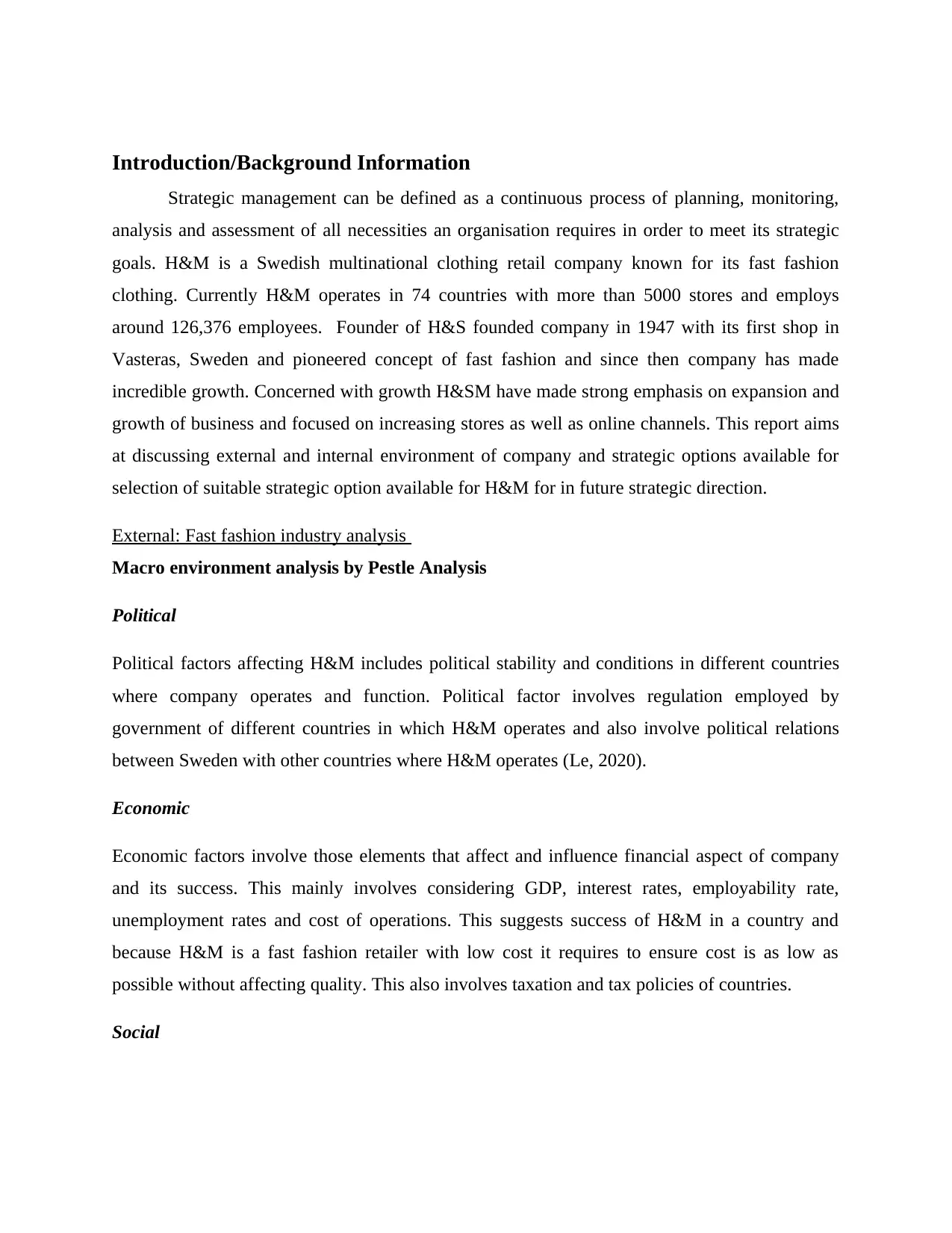
Introduction/Background Information
Strategic management can be defined as a continuous process of planning, monitoring,
analysis and assessment of all necessities an organisation requires in order to meet its strategic
goals. H&M is a Swedish multinational clothing retail company known for its fast fashion
clothing. Currently H&M operates in 74 countries with more than 5000 stores and employs
around 126,376 employees. Founder of H&S founded company in 1947 with its first shop in
Vasteras, Sweden and pioneered concept of fast fashion and since then company has made
incredible growth. Concerned with growth H&SM have made strong emphasis on expansion and
growth of business and focused on increasing stores as well as online channels. This report aims
at discussing external and internal environment of company and strategic options available for
selection of suitable strategic option available for H&M for in future strategic direction.
External: Fast fashion industry analysis
Macro environment analysis by Pestle Analysis
Political
Political factors affecting H&M includes political stability and conditions in different countries
where company operates and function. Political factor involves regulation employed by
government of different countries in which H&M operates and also involve political relations
between Sweden with other countries where H&M operates (Le, 2020).
Economic
Economic factors involve those elements that affect and influence financial aspect of company
and its success. This mainly involves considering GDP, interest rates, employability rate,
unemployment rates and cost of operations. This suggests success of H&M in a country and
because H&M is a fast fashion retailer with low cost it requires to ensure cost is as low as
possible without affecting quality. This also involves taxation and tax policies of countries.
Social
Strategic management can be defined as a continuous process of planning, monitoring,
analysis and assessment of all necessities an organisation requires in order to meet its strategic
goals. H&M is a Swedish multinational clothing retail company known for its fast fashion
clothing. Currently H&M operates in 74 countries with more than 5000 stores and employs
around 126,376 employees. Founder of H&S founded company in 1947 with its first shop in
Vasteras, Sweden and pioneered concept of fast fashion and since then company has made
incredible growth. Concerned with growth H&SM have made strong emphasis on expansion and
growth of business and focused on increasing stores as well as online channels. This report aims
at discussing external and internal environment of company and strategic options available for
selection of suitable strategic option available for H&M for in future strategic direction.
External: Fast fashion industry analysis
Macro environment analysis by Pestle Analysis
Political
Political factors affecting H&M includes political stability and conditions in different countries
where company operates and function. Political factor involves regulation employed by
government of different countries in which H&M operates and also involve political relations
between Sweden with other countries where H&M operates (Le, 2020).
Economic
Economic factors involve those elements that affect and influence financial aspect of company
and its success. This mainly involves considering GDP, interest rates, employability rate,
unemployment rates and cost of operations. This suggests success of H&M in a country and
because H&M is a fast fashion retailer with low cost it requires to ensure cost is as low as
possible without affecting quality. This also involves taxation and tax policies of countries.
Social
⊘ This is a preview!⊘
Do you want full access?
Subscribe today to unlock all pages.

Trusted by 1+ million students worldwide
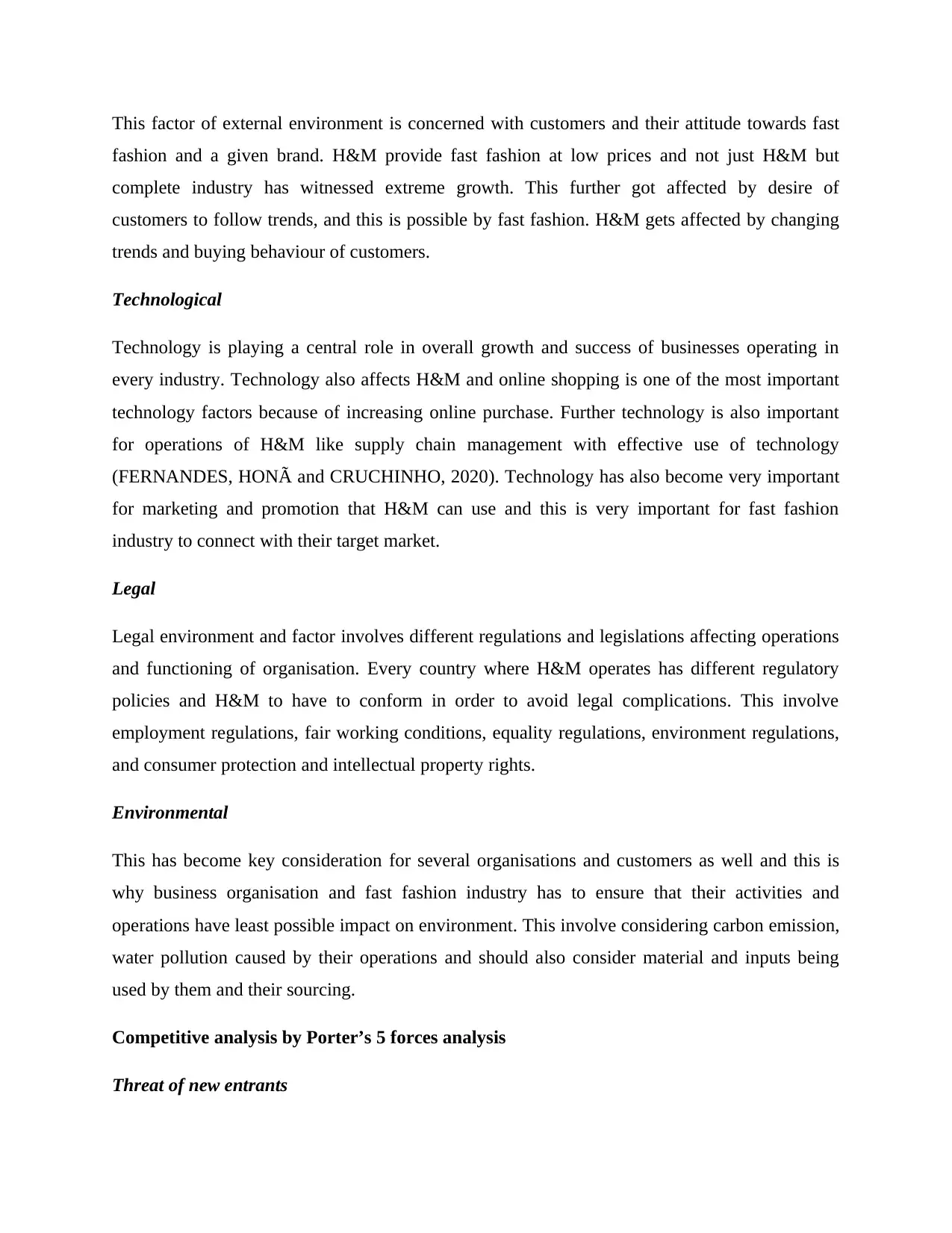
This factor of external environment is concerned with customers and their attitude towards fast
fashion and a given brand. H&M provide fast fashion at low prices and not just H&M but
complete industry has witnessed extreme growth. This further got affected by desire of
customers to follow trends, and this is possible by fast fashion. H&M gets affected by changing
trends and buying behaviour of customers.
Technological
Technology is playing a central role in overall growth and success of businesses operating in
every industry. Technology also affects H&M and online shopping is one of the most important
technology factors because of increasing online purchase. Further technology is also important
for operations of H&M like supply chain management with effective use of technology
(FERNANDES, HONÃ and CRUCHINHO, 2020). Technology has also become very important
for marketing and promotion that H&M can use and this is very important for fast fashion
industry to connect with their target market.
Legal
Legal environment and factor involves different regulations and legislations affecting operations
and functioning of organisation. Every country where H&M operates has different regulatory
policies and H&M to have to conform in order to avoid legal complications. This involve
employment regulations, fair working conditions, equality regulations, environment regulations,
and consumer protection and intellectual property rights.
Environmental
This has become key consideration for several organisations and customers as well and this is
why business organisation and fast fashion industry has to ensure that their activities and
operations have least possible impact on environment. This involve considering carbon emission,
water pollution caused by their operations and should also consider material and inputs being
used by them and their sourcing.
Competitive analysis by Porter’s 5 forces analysis
Threat of new entrants
fashion and a given brand. H&M provide fast fashion at low prices and not just H&M but
complete industry has witnessed extreme growth. This further got affected by desire of
customers to follow trends, and this is possible by fast fashion. H&M gets affected by changing
trends and buying behaviour of customers.
Technological
Technology is playing a central role in overall growth and success of businesses operating in
every industry. Technology also affects H&M and online shopping is one of the most important
technology factors because of increasing online purchase. Further technology is also important
for operations of H&M like supply chain management with effective use of technology
(FERNANDES, HONÃ and CRUCHINHO, 2020). Technology has also become very important
for marketing and promotion that H&M can use and this is very important for fast fashion
industry to connect with their target market.
Legal
Legal environment and factor involves different regulations and legislations affecting operations
and functioning of organisation. Every country where H&M operates has different regulatory
policies and H&M to have to conform in order to avoid legal complications. This involve
employment regulations, fair working conditions, equality regulations, environment regulations,
and consumer protection and intellectual property rights.
Environmental
This has become key consideration for several organisations and customers as well and this is
why business organisation and fast fashion industry has to ensure that their activities and
operations have least possible impact on environment. This involve considering carbon emission,
water pollution caused by their operations and should also consider material and inputs being
used by them and their sourcing.
Competitive analysis by Porter’s 5 forces analysis
Threat of new entrants
Paraphrase This Document
Need a fresh take? Get an instant paraphrase of this document with our AI Paraphraser
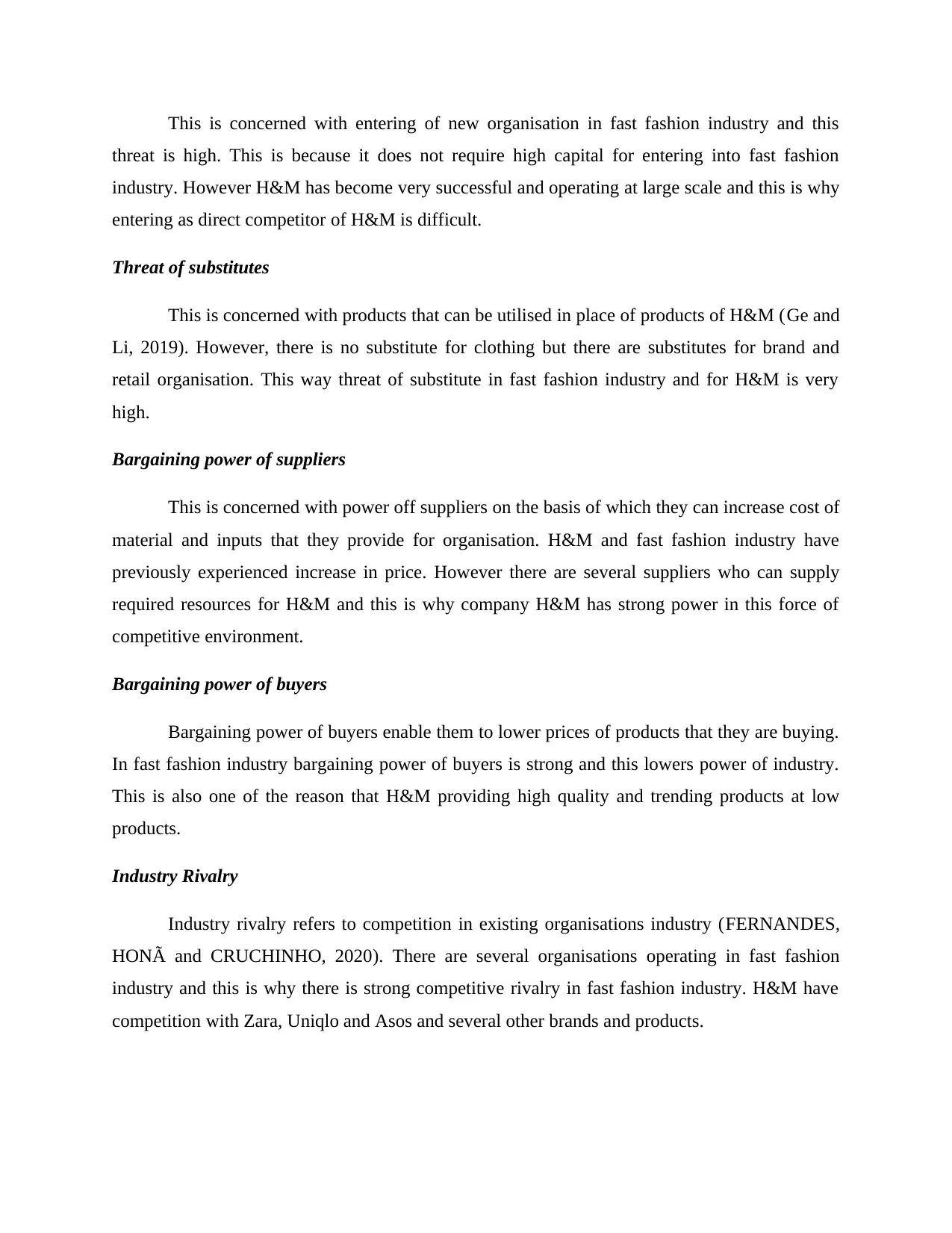
This is concerned with entering of new organisation in fast fashion industry and this
threat is high. This is because it does not require high capital for entering into fast fashion
industry. However H&M has become very successful and operating at large scale and this is why
entering as direct competitor of H&M is difficult.
Threat of substitutes
This is concerned with products that can be utilised in place of products of H&M (Ge and
Li, 2019). However, there is no substitute for clothing but there are substitutes for brand and
retail organisation. This way threat of substitute in fast fashion industry and for H&M is very
high.
Bargaining power of suppliers
This is concerned with power off suppliers on the basis of which they can increase cost of
material and inputs that they provide for organisation. H&M and fast fashion industry have
previously experienced increase in price. However there are several suppliers who can supply
required resources for H&M and this is why company H&M has strong power in this force of
competitive environment.
Bargaining power of buyers
Bargaining power of buyers enable them to lower prices of products that they are buying.
In fast fashion industry bargaining power of buyers is strong and this lowers power of industry.
This is also one of the reason that H&M providing high quality and trending products at low
products.
Industry Rivalry
Industry rivalry refers to competition in existing organisations industry (FERNANDES,
HONÃ and CRUCHINHO, 2020). There are several organisations operating in fast fashion
industry and this is why there is strong competitive rivalry in fast fashion industry. H&M have
competition with Zara, Uniqlo and Asos and several other brands and products.
threat is high. This is because it does not require high capital for entering into fast fashion
industry. However H&M has become very successful and operating at large scale and this is why
entering as direct competitor of H&M is difficult.
Threat of substitutes
This is concerned with products that can be utilised in place of products of H&M (Ge and
Li, 2019). However, there is no substitute for clothing but there are substitutes for brand and
retail organisation. This way threat of substitute in fast fashion industry and for H&M is very
high.
Bargaining power of suppliers
This is concerned with power off suppliers on the basis of which they can increase cost of
material and inputs that they provide for organisation. H&M and fast fashion industry have
previously experienced increase in price. However there are several suppliers who can supply
required resources for H&M and this is why company H&M has strong power in this force of
competitive environment.
Bargaining power of buyers
Bargaining power of buyers enable them to lower prices of products that they are buying.
In fast fashion industry bargaining power of buyers is strong and this lowers power of industry.
This is also one of the reason that H&M providing high quality and trending products at low
products.
Industry Rivalry
Industry rivalry refers to competition in existing organisations industry (FERNANDES,
HONÃ and CRUCHINHO, 2020). There are several organisations operating in fast fashion
industry and this is why there is strong competitive rivalry in fast fashion industry. H&M have
competition with Zara, Uniqlo and Asos and several other brands and products.
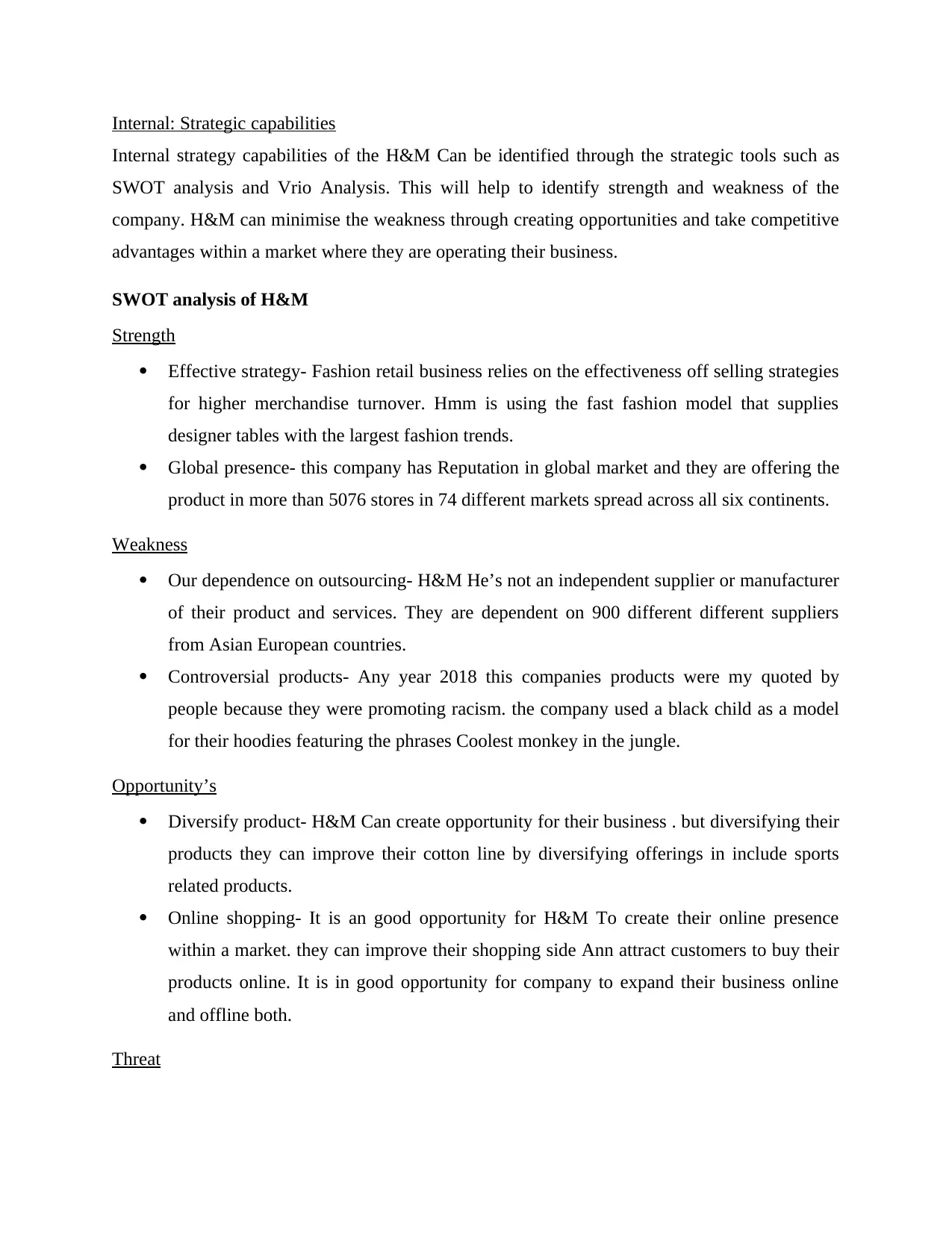
Internal: Strategic capabilities
Internal strategy capabilities of the H&M Can be identified through the strategic tools such as
SWOT analysis and Vrio Analysis. This will help to identify strength and weakness of the
company. H&M can minimise the weakness through creating opportunities and take competitive
advantages within a market where they are operating their business.
SWOT analysis of H&M
Strength
Effective strategy- Fashion retail business relies on the effectiveness off selling strategies
for higher merchandise turnover. Hmm is using the fast fashion model that supplies
designer tables with the largest fashion trends.
Global presence- this company has Reputation in global market and they are offering the
product in more than 5076 stores in 74 different markets spread across all six continents.
Weakness
Our dependence on outsourcing- H&M He’s not an independent supplier or manufacturer
of their product and services. They are dependent on 900 different different suppliers
from Asian European countries.
Controversial products- Any year 2018 this companies products were my quoted by
people because they were promoting racism. the company used a black child as a model
for their hoodies featuring the phrases Coolest monkey in the jungle.
Opportunity’s
Diversify product- H&M Can create opportunity for their business . but diversifying their
products they can improve their cotton line by diversifying offerings in include sports
related products.
Online shopping- It is an good opportunity for H&M To create their online presence
within a market. they can improve their shopping side Ann attract customers to buy their
products online. It is in good opportunity for company to expand their business online
and offline both.
Threat
Internal strategy capabilities of the H&M Can be identified through the strategic tools such as
SWOT analysis and Vrio Analysis. This will help to identify strength and weakness of the
company. H&M can minimise the weakness through creating opportunities and take competitive
advantages within a market where they are operating their business.
SWOT analysis of H&M
Strength
Effective strategy- Fashion retail business relies on the effectiveness off selling strategies
for higher merchandise turnover. Hmm is using the fast fashion model that supplies
designer tables with the largest fashion trends.
Global presence- this company has Reputation in global market and they are offering the
product in more than 5076 stores in 74 different markets spread across all six continents.
Weakness
Our dependence on outsourcing- H&M He’s not an independent supplier or manufacturer
of their product and services. They are dependent on 900 different different suppliers
from Asian European countries.
Controversial products- Any year 2018 this companies products were my quoted by
people because they were promoting racism. the company used a black child as a model
for their hoodies featuring the phrases Coolest monkey in the jungle.
Opportunity’s
Diversify product- H&M Can create opportunity for their business . but diversifying their
products they can improve their cotton line by diversifying offerings in include sports
related products.
Online shopping- It is an good opportunity for H&M To create their online presence
within a market. they can improve their shopping side Ann attract customers to buy their
products online. It is in good opportunity for company to expand their business online
and offline both.
Threat
⊘ This is a preview!⊘
Do you want full access?
Subscribe today to unlock all pages.

Trusted by 1+ million students worldwide
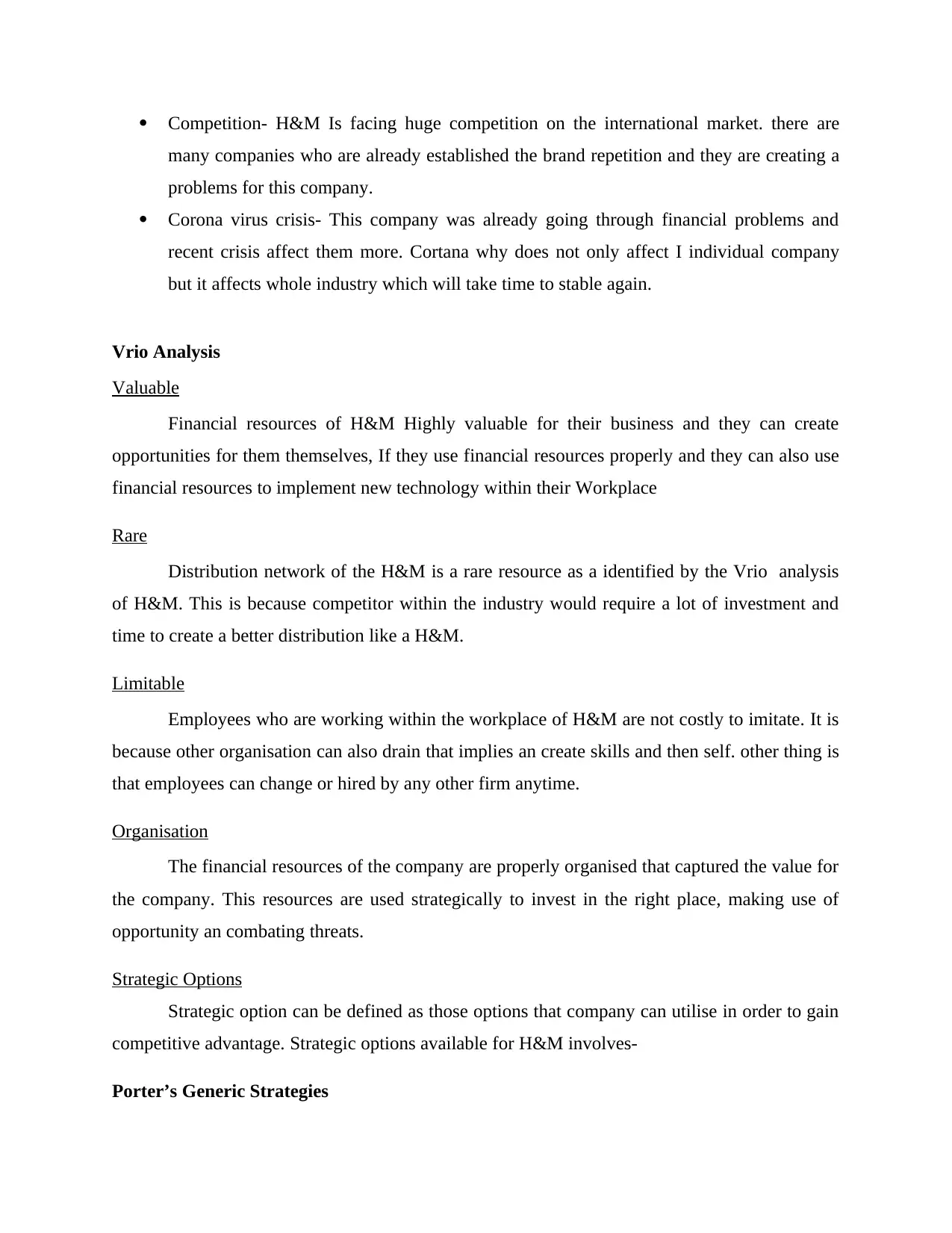
Competition- H&M Is facing huge competition on the international market. there are
many companies who are already established the brand repetition and they are creating a
problems for this company.
Corona virus crisis- This company was already going through financial problems and
recent crisis affect them more. Cortana why does not only affect I individual company
but it affects whole industry which will take time to stable again.
Vrio Analysis
Valuable
Financial resources of H&M Highly valuable for their business and they can create
opportunities for them themselves, If they use financial resources properly and they can also use
financial resources to implement new technology within their Workplace
Rare
Distribution network of the H&M is a rare resource as a identified by the Vrio analysis
of H&M. This is because competitor within the industry would require a lot of investment and
time to create a better distribution like a H&M.
Limitable
Employees who are working within the workplace of H&M are not costly to imitate. It is
because other organisation can also drain that implies an create skills and then self. other thing is
that employees can change or hired by any other firm anytime.
Organisation
The financial resources of the company are properly organised that captured the value for
the company. This resources are used strategically to invest in the right place, making use of
opportunity an combating threats.
Strategic Options
Strategic option can be defined as those options that company can utilise in order to gain
competitive advantage. Strategic options available for H&M involves-
Porter’s Generic Strategies
many companies who are already established the brand repetition and they are creating a
problems for this company.
Corona virus crisis- This company was already going through financial problems and
recent crisis affect them more. Cortana why does not only affect I individual company
but it affects whole industry which will take time to stable again.
Vrio Analysis
Valuable
Financial resources of H&M Highly valuable for their business and they can create
opportunities for them themselves, If they use financial resources properly and they can also use
financial resources to implement new technology within their Workplace
Rare
Distribution network of the H&M is a rare resource as a identified by the Vrio analysis
of H&M. This is because competitor within the industry would require a lot of investment and
time to create a better distribution like a H&M.
Limitable
Employees who are working within the workplace of H&M are not costly to imitate. It is
because other organisation can also drain that implies an create skills and then self. other thing is
that employees can change or hired by any other firm anytime.
Organisation
The financial resources of the company are properly organised that captured the value for
the company. This resources are used strategically to invest in the right place, making use of
opportunity an combating threats.
Strategic Options
Strategic option can be defined as those options that company can utilise in order to gain
competitive advantage. Strategic options available for H&M involves-
Porter’s Generic Strategies
Paraphrase This Document
Need a fresh take? Get an instant paraphrase of this document with our AI Paraphraser
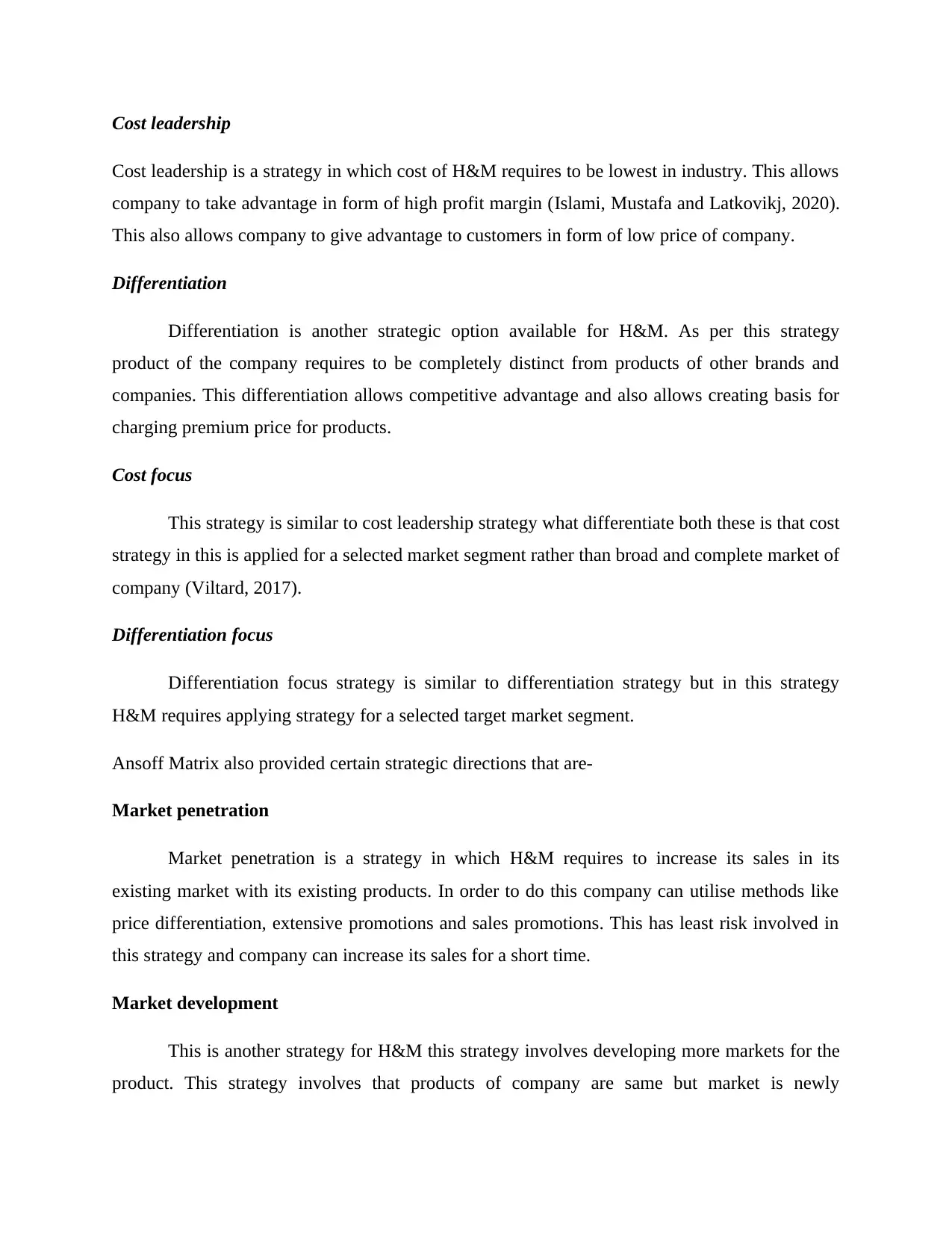
Cost leadership
Cost leadership is a strategy in which cost of H&M requires to be lowest in industry. This allows
company to take advantage in form of high profit margin (Islami, Mustafa and Latkovikj, 2020).
This also allows company to give advantage to customers in form of low price of company.
Differentiation
Differentiation is another strategic option available for H&M. As per this strategy
product of the company requires to be completely distinct from products of other brands and
companies. This differentiation allows competitive advantage and also allows creating basis for
charging premium price for products.
Cost focus
This strategy is similar to cost leadership strategy what differentiate both these is that cost
strategy in this is applied for a selected market segment rather than broad and complete market of
company (Viltard, 2017).
Differentiation focus
Differentiation focus strategy is similar to differentiation strategy but in this strategy
H&M requires applying strategy for a selected target market segment.
Ansoff Matrix also provided certain strategic directions that are-
Market penetration
Market penetration is a strategy in which H&M requires to increase its sales in its
existing market with its existing products. In order to do this company can utilise methods like
price differentiation, extensive promotions and sales promotions. This has least risk involved in
this strategy and company can increase its sales for a short time.
Market development
This is another strategy for H&M this strategy involves developing more markets for the
product. This strategy involves that products of company are same but market is newly
Cost leadership is a strategy in which cost of H&M requires to be lowest in industry. This allows
company to take advantage in form of high profit margin (Islami, Mustafa and Latkovikj, 2020).
This also allows company to give advantage to customers in form of low price of company.
Differentiation
Differentiation is another strategic option available for H&M. As per this strategy
product of the company requires to be completely distinct from products of other brands and
companies. This differentiation allows competitive advantage and also allows creating basis for
charging premium price for products.
Cost focus
This strategy is similar to cost leadership strategy what differentiate both these is that cost
strategy in this is applied for a selected market segment rather than broad and complete market of
company (Viltard, 2017).
Differentiation focus
Differentiation focus strategy is similar to differentiation strategy but in this strategy
H&M requires applying strategy for a selected target market segment.
Ansoff Matrix also provided certain strategic directions that are-
Market penetration
Market penetration is a strategy in which H&M requires to increase its sales in its
existing market with its existing products. In order to do this company can utilise methods like
price differentiation, extensive promotions and sales promotions. This has least risk involved in
this strategy and company can increase its sales for a short time.
Market development
This is another strategy for H&M this strategy involves developing more markets for the
product. This strategy involves that products of company are same but market is newly
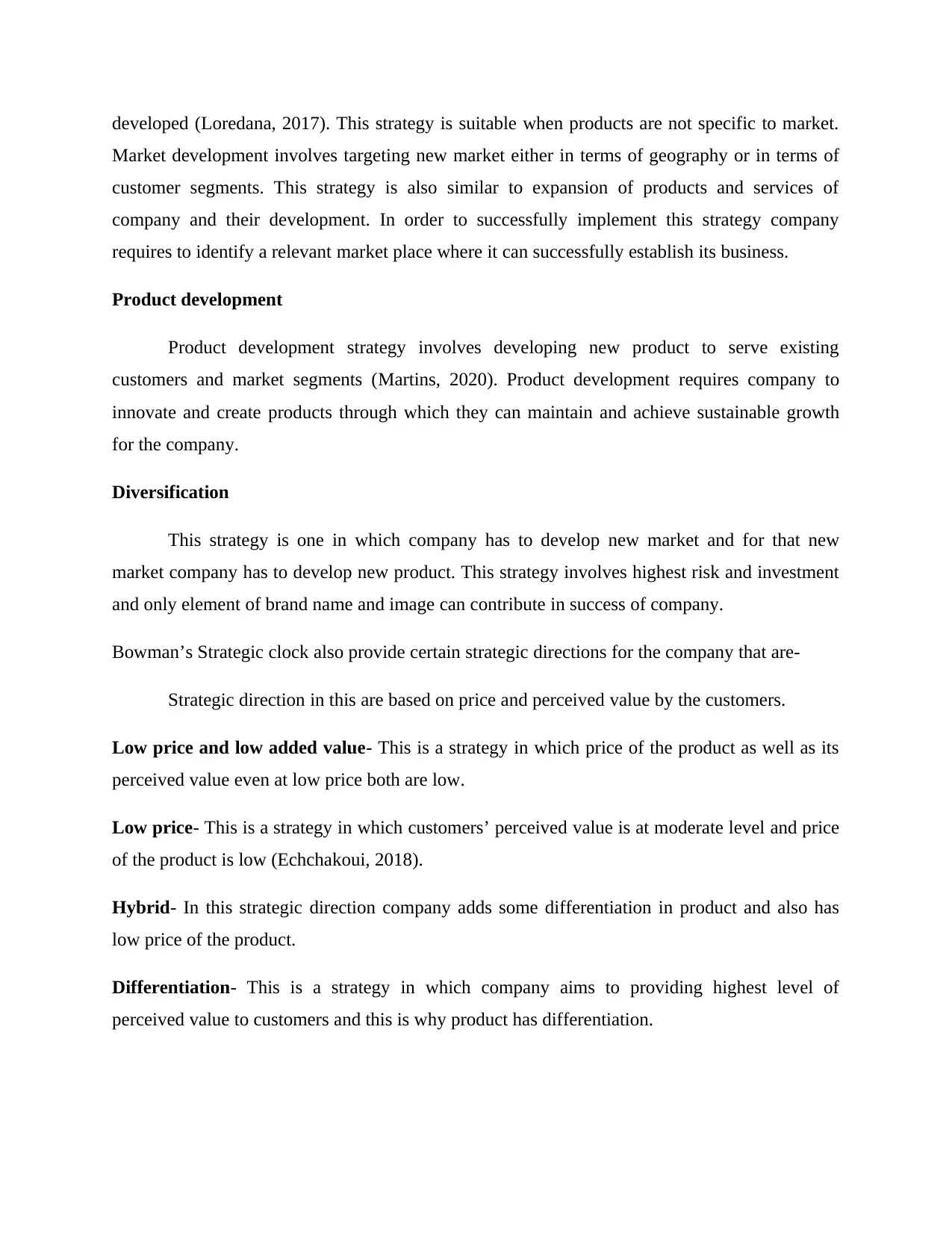
developed (Loredana, 2017). This strategy is suitable when products are not specific to market.
Market development involves targeting new market either in terms of geography or in terms of
customer segments. This strategy is also similar to expansion of products and services of
company and their development. In order to successfully implement this strategy company
requires to identify a relevant market place where it can successfully establish its business.
Product development
Product development strategy involves developing new product to serve existing
customers and market segments (Martins, 2020). Product development requires company to
innovate and create products through which they can maintain and achieve sustainable growth
for the company.
Diversification
This strategy is one in which company has to develop new market and for that new
market company has to develop new product. This strategy involves highest risk and investment
and only element of brand name and image can contribute in success of company.
Bowman’s Strategic clock also provide certain strategic directions for the company that are-
Strategic direction in this are based on price and perceived value by the customers.
Low price and low added value- This is a strategy in which price of the product as well as its
perceived value even at low price both are low.
Low price- This is a strategy in which customers’ perceived value is at moderate level and price
of the product is low (Echchakoui, 2018).
Hybrid- In this strategic direction company adds some differentiation in product and also has
low price of the product.
Differentiation- This is a strategy in which company aims to providing highest level of
perceived value to customers and this is why product has differentiation.
Market development involves targeting new market either in terms of geography or in terms of
customer segments. This strategy is also similar to expansion of products and services of
company and their development. In order to successfully implement this strategy company
requires to identify a relevant market place where it can successfully establish its business.
Product development
Product development strategy involves developing new product to serve existing
customers and market segments (Martins, 2020). Product development requires company to
innovate and create products through which they can maintain and achieve sustainable growth
for the company.
Diversification
This strategy is one in which company has to develop new market and for that new
market company has to develop new product. This strategy involves highest risk and investment
and only element of brand name and image can contribute in success of company.
Bowman’s Strategic clock also provide certain strategic directions for the company that are-
Strategic direction in this are based on price and perceived value by the customers.
Low price and low added value- This is a strategy in which price of the product as well as its
perceived value even at low price both are low.
Low price- This is a strategy in which customers’ perceived value is at moderate level and price
of the product is low (Echchakoui, 2018).
Hybrid- In this strategic direction company adds some differentiation in product and also has
low price of the product.
Differentiation- This is a strategy in which company aims to providing highest level of
perceived value to customers and this is why product has differentiation.
⊘ This is a preview!⊘
Do you want full access?
Subscribe today to unlock all pages.

Trusted by 1+ million students worldwide
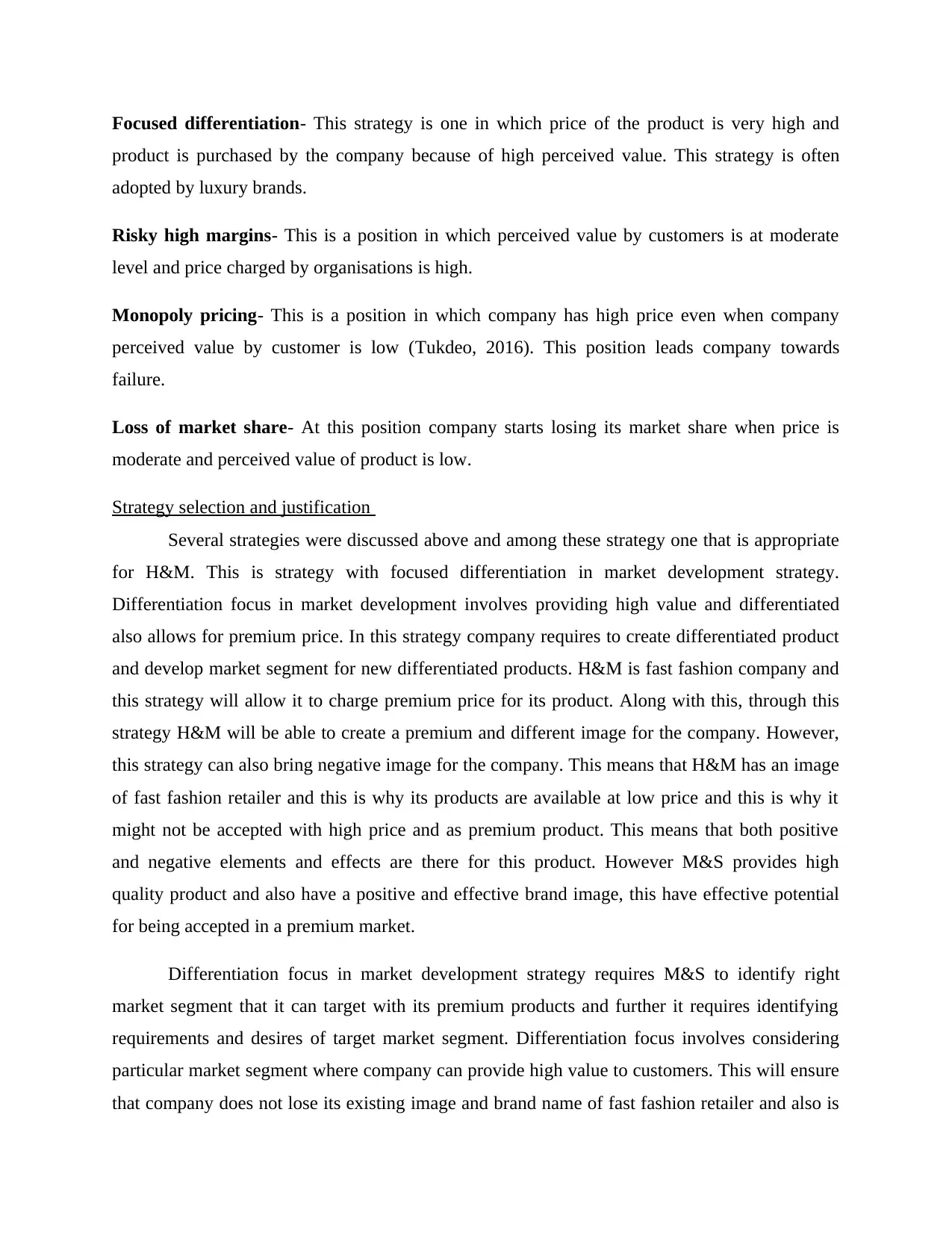
Focused differentiation- This strategy is one in which price of the product is very high and
product is purchased by the company because of high perceived value. This strategy is often
adopted by luxury brands.
Risky high margins- This is a position in which perceived value by customers is at moderate
level and price charged by organisations is high.
Monopoly pricing- This is a position in which company has high price even when company
perceived value by customer is low (Tukdeo, 2016). This position leads company towards
failure.
Loss of market share- At this position company starts losing its market share when price is
moderate and perceived value of product is low.
Strategy selection and justification
Several strategies were discussed above and among these strategy one that is appropriate
for H&M. This is strategy with focused differentiation in market development strategy.
Differentiation focus in market development involves providing high value and differentiated
also allows for premium price. In this strategy company requires to create differentiated product
and develop market segment for new differentiated products. H&M is fast fashion company and
this strategy will allow it to charge premium price for its product. Along with this, through this
strategy H&M will be able to create a premium and different image for the company. However,
this strategy can also bring negative image for the company. This means that H&M has an image
of fast fashion retailer and this is why its products are available at low price and this is why it
might not be accepted with high price and as premium product. This means that both positive
and negative elements and effects are there for this product. However M&S provides high
quality product and also have a positive and effective brand image, this have effective potential
for being accepted in a premium market.
Differentiation focus in market development strategy requires M&S to identify right
market segment that it can target with its premium products and further it requires identifying
requirements and desires of target market segment. Differentiation focus involves considering
particular market segment where company can provide high value to customers. This will ensure
that company does not lose its existing image and brand name of fast fashion retailer and also is
product is purchased by the company because of high perceived value. This strategy is often
adopted by luxury brands.
Risky high margins- This is a position in which perceived value by customers is at moderate
level and price charged by organisations is high.
Monopoly pricing- This is a position in which company has high price even when company
perceived value by customer is low (Tukdeo, 2016). This position leads company towards
failure.
Loss of market share- At this position company starts losing its market share when price is
moderate and perceived value of product is low.
Strategy selection and justification
Several strategies were discussed above and among these strategy one that is appropriate
for H&M. This is strategy with focused differentiation in market development strategy.
Differentiation focus in market development involves providing high value and differentiated
also allows for premium price. In this strategy company requires to create differentiated product
and develop market segment for new differentiated products. H&M is fast fashion company and
this strategy will allow it to charge premium price for its product. Along with this, through this
strategy H&M will be able to create a premium and different image for the company. However,
this strategy can also bring negative image for the company. This means that H&M has an image
of fast fashion retailer and this is why its products are available at low price and this is why it
might not be accepted with high price and as premium product. This means that both positive
and negative elements and effects are there for this product. However M&S provides high
quality product and also have a positive and effective brand image, this have effective potential
for being accepted in a premium market.
Differentiation focus in market development strategy requires M&S to identify right
market segment that it can target with its premium products and further it requires identifying
requirements and desires of target market segment. Differentiation focus involves considering
particular market segment where company can provide high value to customers. This will ensure
that company does not lose its existing image and brand name of fast fashion retailer and also is
Paraphrase This Document
Need a fresh take? Get an instant paraphrase of this document with our AI Paraphraser
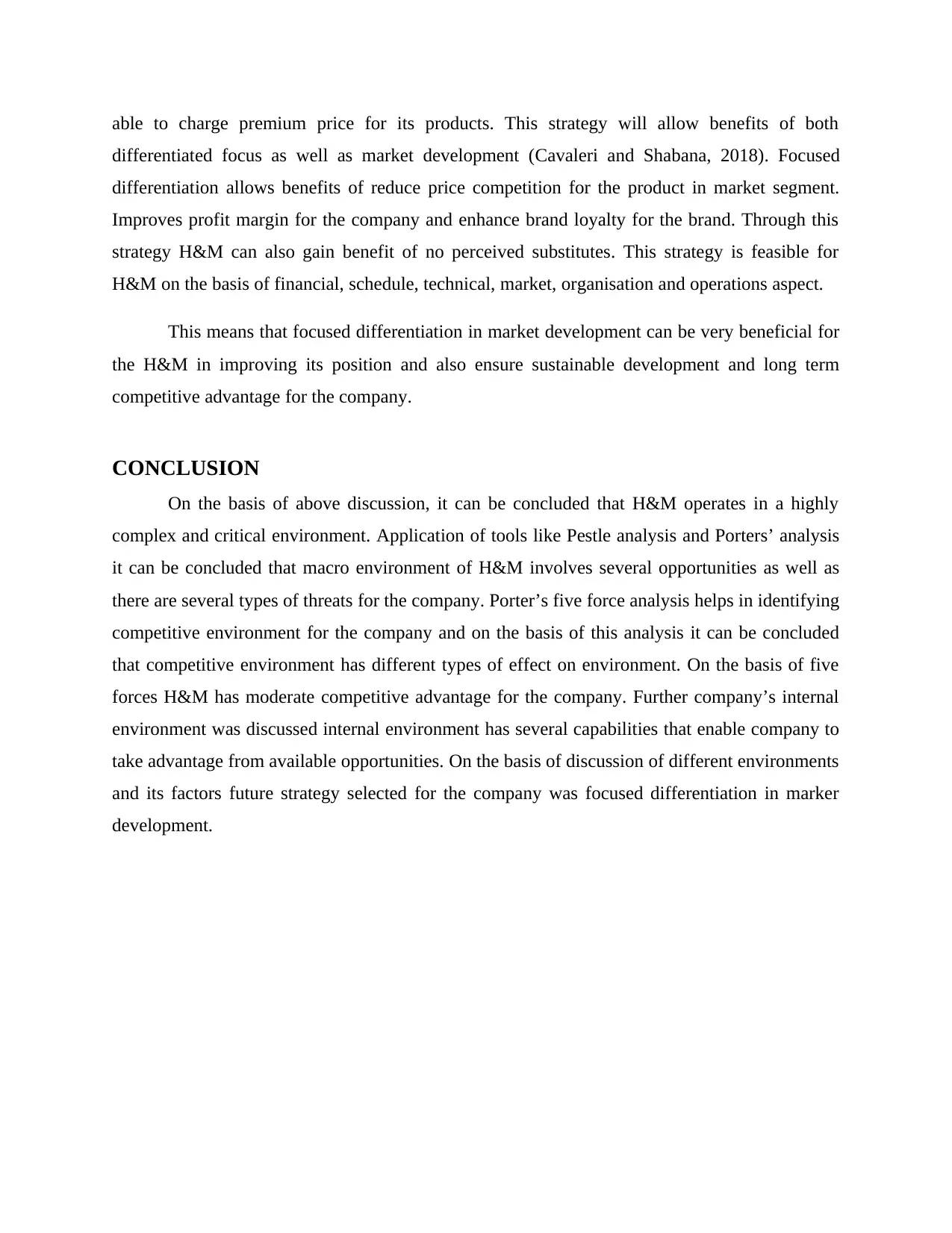
able to charge premium price for its products. This strategy will allow benefits of both
differentiated focus as well as market development (Cavaleri and Shabana, 2018). Focused
differentiation allows benefits of reduce price competition for the product in market segment.
Improves profit margin for the company and enhance brand loyalty for the brand. Through this
strategy H&M can also gain benefit of no perceived substitutes. This strategy is feasible for
H&M on the basis of financial, schedule, technical, market, organisation and operations aspect.
This means that focused differentiation in market development can be very beneficial for
the H&M in improving its position and also ensure sustainable development and long term
competitive advantage for the company.
CONCLUSION
On the basis of above discussion, it can be concluded that H&M operates in a highly
complex and critical environment. Application of tools like Pestle analysis and Porters’ analysis
it can be concluded that macro environment of H&M involves several opportunities as well as
there are several types of threats for the company. Porter’s five force analysis helps in identifying
competitive environment for the company and on the basis of this analysis it can be concluded
that competitive environment has different types of effect on environment. On the basis of five
forces H&M has moderate competitive advantage for the company. Further company’s internal
environment was discussed internal environment has several capabilities that enable company to
take advantage from available opportunities. On the basis of discussion of different environments
and its factors future strategy selected for the company was focused differentiation in marker
development.
differentiated focus as well as market development (Cavaleri and Shabana, 2018). Focused
differentiation allows benefits of reduce price competition for the product in market segment.
Improves profit margin for the company and enhance brand loyalty for the brand. Through this
strategy H&M can also gain benefit of no perceived substitutes. This strategy is feasible for
H&M on the basis of financial, schedule, technical, market, organisation and operations aspect.
This means that focused differentiation in market development can be very beneficial for
the H&M in improving its position and also ensure sustainable development and long term
competitive advantage for the company.
CONCLUSION
On the basis of above discussion, it can be concluded that H&M operates in a highly
complex and critical environment. Application of tools like Pestle analysis and Porters’ analysis
it can be concluded that macro environment of H&M involves several opportunities as well as
there are several types of threats for the company. Porter’s five force analysis helps in identifying
competitive environment for the company and on the basis of this analysis it can be concluded
that competitive environment has different types of effect on environment. On the basis of five
forces H&M has moderate competitive advantage for the company. Further company’s internal
environment was discussed internal environment has several capabilities that enable company to
take advantage from available opportunities. On the basis of discussion of different environments
and its factors future strategy selected for the company was focused differentiation in marker
development.
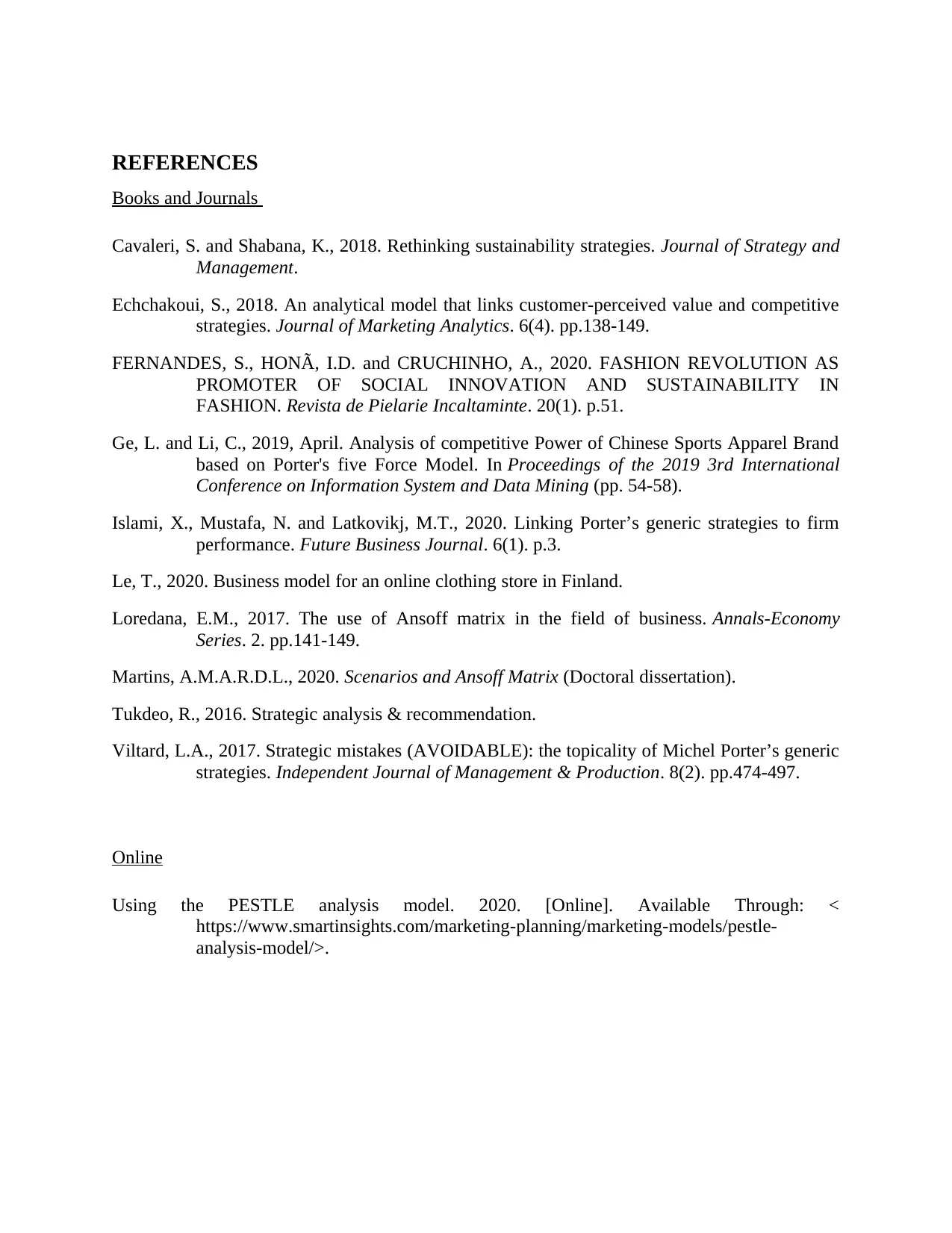
REFERENCES
Books and Journals
Cavaleri, S. and Shabana, K., 2018. Rethinking sustainability strategies. Journal of Strategy and
Management.
Echchakoui, S., 2018. An analytical model that links customer-perceived value and competitive
strategies. Journal of Marketing Analytics. 6(4). pp.138-149.
FERNANDES, S., HONÃ, I.D. and CRUCHINHO, A., 2020. FASHION REVOLUTION AS
PROMOTER OF SOCIAL INNOVATION AND SUSTAINABILITY IN
FASHION. Revista de Pielarie Incaltaminte. 20(1). p.51.
Ge, L. and Li, C., 2019, April. Analysis of competitive Power of Chinese Sports Apparel Brand
based on Porter's five Force Model. In Proceedings of the 2019 3rd International
Conference on Information System and Data Mining (pp. 54-58).
Islami, X., Mustafa, N. and Latkovikj, M.T., 2020. Linking Porter’s generic strategies to firm
performance. Future Business Journal. 6(1). p.3.
Le, T., 2020. Business model for an online clothing store in Finland.
Loredana, E.M., 2017. The use of Ansoff matrix in the field of business. Annals-Economy
Series. 2. pp.141-149.
Martins, A.M.A.R.D.L., 2020. Scenarios and Ansoff Matrix (Doctoral dissertation).
Tukdeo, R., 2016. Strategic analysis & recommendation.
Viltard, L.A., 2017. Strategic mistakes (AVOIDABLE): the topicality of Michel Porter’s generic
strategies. Independent Journal of Management & Production. 8(2). pp.474-497.
Online
Using the PESTLE analysis model. 2020. [Online]. Available Through: <
https://www.smartinsights.com/marketing-planning/marketing-models/pestle-
analysis-model/>.
Books and Journals
Cavaleri, S. and Shabana, K., 2018. Rethinking sustainability strategies. Journal of Strategy and
Management.
Echchakoui, S., 2018. An analytical model that links customer-perceived value and competitive
strategies. Journal of Marketing Analytics. 6(4). pp.138-149.
FERNANDES, S., HONÃ, I.D. and CRUCHINHO, A., 2020. FASHION REVOLUTION AS
PROMOTER OF SOCIAL INNOVATION AND SUSTAINABILITY IN
FASHION. Revista de Pielarie Incaltaminte. 20(1). p.51.
Ge, L. and Li, C., 2019, April. Analysis of competitive Power of Chinese Sports Apparel Brand
based on Porter's five Force Model. In Proceedings of the 2019 3rd International
Conference on Information System and Data Mining (pp. 54-58).
Islami, X., Mustafa, N. and Latkovikj, M.T., 2020. Linking Porter’s generic strategies to firm
performance. Future Business Journal. 6(1). p.3.
Le, T., 2020. Business model for an online clothing store in Finland.
Loredana, E.M., 2017. The use of Ansoff matrix in the field of business. Annals-Economy
Series. 2. pp.141-149.
Martins, A.M.A.R.D.L., 2020. Scenarios and Ansoff Matrix (Doctoral dissertation).
Tukdeo, R., 2016. Strategic analysis & recommendation.
Viltard, L.A., 2017. Strategic mistakes (AVOIDABLE): the topicality of Michel Porter’s generic
strategies. Independent Journal of Management & Production. 8(2). pp.474-497.
Online
Using the PESTLE analysis model. 2020. [Online]. Available Through: <
https://www.smartinsights.com/marketing-planning/marketing-models/pestle-
analysis-model/>.
⊘ This is a preview!⊘
Do you want full access?
Subscribe today to unlock all pages.

Trusted by 1+ million students worldwide
1 out of 13
Related Documents
Your All-in-One AI-Powered Toolkit for Academic Success.
+13062052269
info@desklib.com
Available 24*7 on WhatsApp / Email
![[object Object]](/_next/static/media/star-bottom.7253800d.svg)
Unlock your academic potential
Copyright © 2020–2025 A2Z Services. All Rights Reserved. Developed and managed by ZUCOL.





